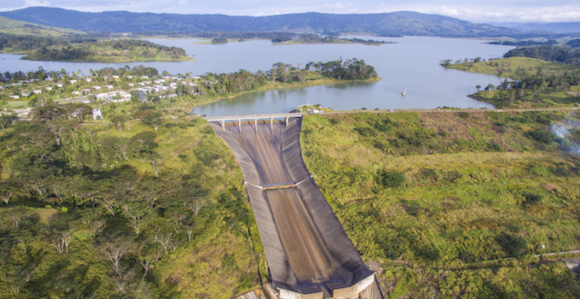Papua New Guinea has some ambitious plans to expand its population’s access to electricity. However, boosting electricity supply across the country requires ‘some very clever thinking,’ say energy analysts.

PNG Hydro power as an energy source. Source: PNG Power
Expanding Papua New Guinea’s power network requires a variety of approaches, some ‘very clever thinking’, and helping small communities develop sustainable incomes to pay for power.
That is the view of energy analyst, Craig Lawrence, who believes that state utility PNG Power (PPL) must look beyond its emphasis on power generation and grids.
At the heart of the debate over PNG Power’s challenges is the government’s ambitious policy of providing access to electricity to 70 per cent of the country by 2030.
It is currently between 12 and 13 per cent, according to the acting Managing Director of PPL, Carolyn Blacklock.
‘Electrification of PNG will be a progressive series of steps.’
Queensland-based analyst Craig Lawrence says there is no single approach to achieving the government’s aim.
He agrees that in the short-to-medium term, smaller regional-based, renewable projects are likely to be ‘the most cost-effective solution’.
Payment

Energy analyst Craig Lawrence.
Lawrence tells Business Advantage PNG that the real challenge is people’s ability to pay for their electricity service.
He adds that the electrification of PNG will be a ‘progressive’ series of steps.
While the long-term aim should be ‘to provide electricity 24/7 with virtually no brownouts’, reliability of supply is something that will have to develop ‘over time’.
‘Papua New Guineans are moving away from a traditional, subsistence lifestyle because they want to buy goods and services that are typically supplied in a cash economy,’ he tells Business Advantage PNG.
‘So, the bigger question is how to develop that cash economy in regional areas so that some things can be supplied there.’
PPL manages the generation, transmission, and distribution over three main grids (Port Moresby, Ramu, and Gazelle), which serve the main urban centres, plus 19 isolated independent power grids servicing provincial centres.
PNG’s installed capacity is approximately 260 MW (66 per cent hydro, 44 per cent thermal) with independent power producers adding 50 MW of thermal capacity.
Another 280 MW is generated by the mining industry for its own consumption.
Planning
An estimated US$5 billion worth of major electricity supply projects is planned or underway to boost the faltering existing grids, but these alone are unlikely to make the impact required in rural and remote areas of the country to achieve the government’s goal.
‘Demand has to come from each village. Each has to come up with a plan.’
For villages with populations of fewer than 2000 people located further than 5 kilometres from the existing grid, even the highest cost stand-alone alternative was more cost efficient than extending the grid, according to the Powering PNG into the Asian Century report, prepared by Port Jackson Partners for ANZ Bank.
According to one donor agency analyst and consultant Business Advantage PNG spoke to, demand has to come from each village. Each has to come up with a plan and then convince the donor that they can keep it going.
‘Donors aren’t going to be there all the time,’ they point out, ‘so they have to come up with a scheme that enables even poor communities to have enough money to maintain the system.
‘They need to create enough capacity to generate business income to pay for the power.’
Assets
The donor agency analyst says some of these power supply assets ‘may just have to be gifted’ for basic items like lighting and fridges, which would expand villagers’ days and open up income-earning opportunities.
‘Then it’s time to start talking with communities to collaborate on the construction of mini-hydro schemes—where people are pulling a little bit of energy out of the flow of a river without necessarily damming it up.
‘In high rainfall environments, you’ve got very consistent water flows and, in parts of PNG, that might be all that’s needed.’
Craig Lawrence says there is also a call for a cultural change in PPL, which, he believes, ‘has a traditional utility culture in which the focus is on power generation and the grid’.
‘That’s not being disrespectful to PNG Power. That’s how they’ve recruited their engineers.
‘In Australia, we had similar organisations which were not going to provide innovative ideas. Some didn’t last.’
Craig Lawrence will present PNG’s Infrastructure Report Card at Business Advantage’s 2018 Papua New Guinea Investment Conference. The conference will be held at the Sofitel Brisbane on 6 & 7 August. To view the program or register to attend, visit www.pnginvestmentconference.com.








Speak Your Mind